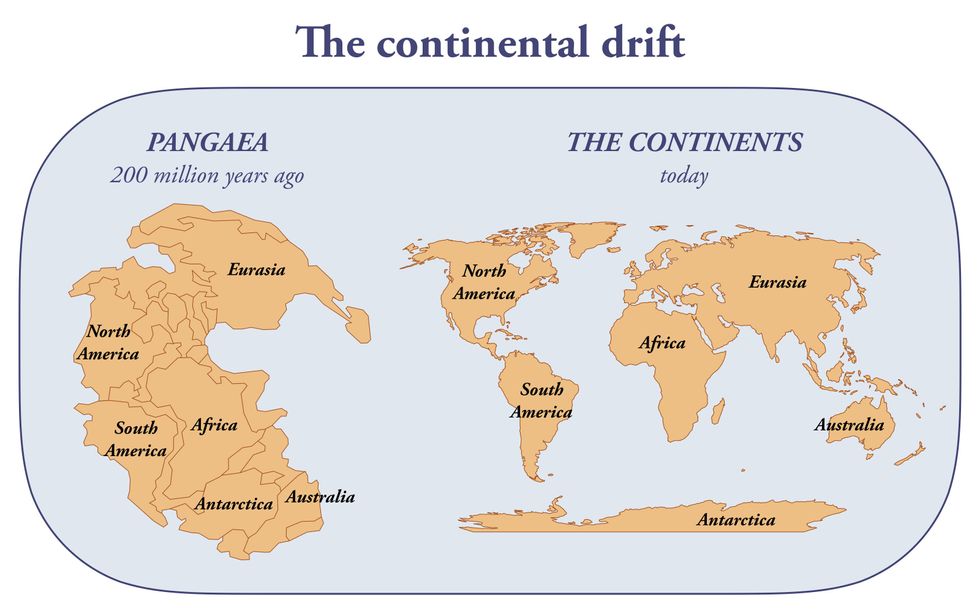Science & Tech
Sinead Butler
Feb 05, 2025
What If Pangea Never Broke Apart?
Underknown - Shorts / VideoElephant
Back in the day (and by that, we mean around 230 million years ago), there used to be one big supercontinent called Pangea but as we all know this slowly broke apart what emerged the continental drift is the world we’re familiar with today.
Although it’s hard to imagine a world where there’s one supercontinent, there’s the fossil evidence of ancient species whose habitat eventually broke off. For example, fossils of Cynognathus an extinct mammal-like reptile the size of a modern wolf have only been found in Africa and South America – which suggests the two continents were once joined, according to The Geology Society.
But due to Earth’s soft centre and the tectonic plates, the contents are still moving today – in fact, it is thought that Africa will split in two in the future.
However when we say “future” it is actually a long way off, as the seismic split is expected to take around 50 million years, according to National Geographic.
So how have experts made this prediction?
Africa is home to one of the largest rifts in the world - the East African Rift System (EARS) – which is so big it goes through a number of countries such as Ethiopia, Kenya, the Democratic Republic of the Congo, Uganda, Rwanda, Burundi, Zambia, Tanzania, Malawi, and Mozambique.
Basically, a crack has emerged in this area and will eventually break away which will separate the smaller Somalian plate from the larger Nubian plate. You’d be mistaken to think this is a quick process as it has taken a whopping 25 million years for this crack to develop.
When it does eventually break away in the very distant future, a new sixth ocean will form and consequently previously landlocked countries such as Rwanda, Uganda, Burundi, the Democratic Republic of Congo, Malawi, and Zambia will get a coastline.

This subject matter of the continent breaking away gained more attention when back in 2018 a huge crack (50 feet deep and 65 feet wide in some spots, local outlets reported at the time) in the Kenyan Rift Valley made headlines and its placement raised eyebrows online. Was this a result of tectonic movement or just a case of soil erosion from the heavy rain?
“The valley has a history of tectonic and volcanic activities,” geologist David Adede told the Daily Nation at the time “Whereas the rift has remained tectonically inactive in the recent past, there could be movements deep within the Earth’s crust that have resulted in zones of weakness extending all the way to the surface.”
“Given the evidence available at present, the best and simplest explanation is that this crack was in fact formed by erosion of soil beneath the surface due to recent heavy rains in Kenya,” Stephen Hicks, a seismology researcher at the University of Southampton wrote in The Guardian.
Writing in The Conversation, Lucía Pérez Díaz, at the time a postdoctoral researcher in the Fault Dynamics Research Group at the Royal Holloway University of London noted how “Questions remain as to why it has formed in the location that it did and whether its appearance is at all connected to the ongoing East African Rift.
“For example, the crack could be the result of the erosion of soft soils infilling an old rift-related fault.”
If the idea of Earth’s continents once being joined together and splitting off over the course of millions of years, then you’ll be even more stunned to learn that the continents have come together and split apart (extremely slowly) at least three times over the course of Earth’s long history.
Mind blown.
In other major geological news, a landmass which was once home to up to half a million people has been discovered off the coast of northern Australia, and, amazingly, a whole new continent has been found lurking beneath the icy waters of the northern Atlantic Ocean.
This article was first published on October 27, 2024
How to join the indy100's free WhatsApp channel
Sign up to our free indy100 weekly newsletter
Have your say in our news democracy. Click the upvote icon at the top of the page to help raise this article through the indy100 rankings.
Top 100
The Conversation (0)














